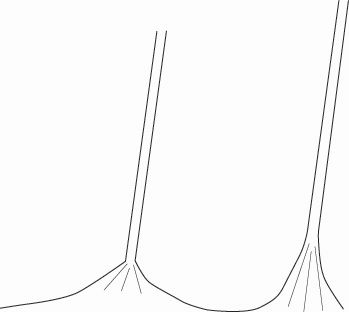Yep, this may be a “worn-out” subject; but a subject that’s always NEW to a new client.
Thing is, if you are uninterested in a topic you don’t have to say anything; let the others “do it.” I don’t speak to a LOT of topics for that same reason. (I gave up on the “counting hairs per minutes” thing.)
Yep, after YEARS of this, there are few brand-new topics. Still, clients are always FRESH and always give me a sort of excitement about explaining our procedures. It always seem new to me with a nice fresh person!
So, I did a fast drawing to illustrate a point about “tugging.” The lesson comes from people that get their body hairs WAXED! On an unshaven area, say a guy’s back, the waxing is excruciating. However, if a person is waxing all the time (like a woman’s legs), it’s not so bad. It’s all about telogen hairs.
A frequent waxer shows only anagen hairs. These early growers are easy to extract; not so the telogen hairs.
Remember that the hair root is actually the epidermis. The epidermis is relatively “hard and dry” (keratinized) and the so-called “grain of sand” is not actually a hair root (only) it’s the epidermis! It’s not “stuck to the follicle,” it’s the skin itself.
Furthermore, the epidermis is populated with tiny nerve endings that give your skin its amazing sensitivity. These nerve endings are EXACTLY where the telogen hair is “attached” to the skin. This telogen hair is seriously attached to the skin and not easy to tweeze (remember, it’s hard and is the skin itself!). Pull on these “puppies” and they “hurt like the dickens!”
Electrologists removing said “stuck in the skin” very-late-stage telogen hairs seldom can zap them out without a “little tug.” I can’t do it. And, because these are attached to nerve endings, you REALLY feel this “tug.”
As James once said, it’s all about the end results! You know, if the process worked or not and how expensive the job was. Judging a zaparette’s skill by counting “hairs per minute,” or modality, or how the thing feels … well, it’s pretty much useless for the client.
Still, if you ARE feeling a LOT of tweezing that’s a bad indication.
(Note, those tiny lines under the epidermis show the location of nerve endings (they don’t look like that, of course … there are billions of them).





